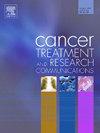Factors influencing the diagnostic basis in pancreatic cancer. A study within the European Prospective Investigation into Cancer and Nutrition (EPIC) cohort
IF 2.4
Q3 Medicine
引用次数: 0
Abstract
Background and aims
Substantial differences have been reported in risk estimates for etiologic factors of pancreatic cancer among subjects with different degrees of diagnostic certainty. The aim of the study was to assess the influence of some personal and social characteristics on the diagnostic basis in individuals with pancreatic cancer.
Methods
We analyzed 393 participants from the EPIC cohort with a diagnosis of pancreatic cancer and information on the basis of diagnosis. Two main groups of cases were compared: one in which microscopic confirmation (MC) was available to diagnose pancreatic cancer (including autopsy, histology, cytology or hematology), and one in which non-microscopic methods were used (biochemical, immunological or image tests, exploratory surgery, clinical observation, self-report, or death certificate).
Results
The diagnosis of pancreatic cancer of 73% of participants was achieved through MC. While, overall, over 82% of men had MC, this figure was 65% in women (p<0.001). Subjects with MC, both men and women, were younger at diagnosis than participants diagnosed by non-microscopic methods. Younger women (<60 years) had a higher probability of having their cancer diagnosed with MC (OR=2.54, 95% CI 1.04-6.17) than women ≥70 years. After the year 2000 the chances of having the disease diagnosed through MC increased more than 2-fold in women and more than 5-fold in men. No significant differences in diagnostic basis were observed by educational level, comorbidities or established risk factors for pancreatic cancer.
Conclusion
The rates of MC in subjects diagnosed with pancreatic cancer continued to be relatively low. Age and sex are the two main factors that powerfully influence MC. Hence, age and sex must be considered when designing and analyzing clinical and epidemiological studies, as well as in clinical practice. The consistently lower rates of MC in female patients suggest an ingrained sex-related diagnostic bias, which may require specific policies to be counterbalanced.
影响胰腺癌诊断依据的因素。欧洲癌症和营养前瞻性调查(EPIC)队列中的一项研究
背景和目的有报道称,在诊断确定性程度不同的受试者中,胰腺癌病因的风险估计存在实质性差异。该研究的目的是评估一些个人和社会特征对胰腺癌患者诊断基础的影响。方法对393例确诊为胰腺癌的EPIC队列患者及基于诊断的信息进行分析。比较两组主要病例:一组使用显微镜确认(MC)诊断胰腺癌(包括尸检、组织学、细胞学或血液学),另一组使用非显微镜方法(生化、免疫学或图像检查、探查性手术、临床观察、自我报告或死亡证明)。结果73%的参与者通过MC诊断出胰腺癌。而总体而言,超过82%的男性患有MC,这一数字在女性中为65% (p<0.001)。患有MC的受试者,无论男性还是女性,在诊断时都比用非显微镜方法诊断的受试者年轻。年轻女性(60岁)与年龄≥70岁的女性相比,被诊断为MC的概率更高(OR=2.54, 95% CI 1.04-6.17)。2000年以后,通过MC诊断出这种疾病的机会在女性中增加了2倍以上,在男性中增加了5倍以上。胰腺癌的教育水平、合并症或已确定的危险因素在诊断基础上无显著差异。结论胰腺癌患者MC的发生率仍相对较低。年龄和性别是影响MC的两个主要因素。因此,在设计和分析临床和流行病学研究以及临床实践时,必须考虑年龄和性别。女性患者的MC率持续较低,这表明与性别相关的诊断偏见根深蒂固,可能需要具体的政策来平衡。
本文章由计算机程序翻译,如有差异,请以英文原文为准。
求助全文
约1分钟内获得全文
求助全文
来源期刊

Cancer treatment and research communications
Medicine-Oncology
CiteScore
4.30
自引率
0.00%
发文量
148
审稿时长
56 days
期刊介绍:
Cancer Treatment and Research Communications is an international peer-reviewed publication dedicated to providing comprehensive basic, translational, and clinical oncology research. The journal is devoted to articles on detection, diagnosis, prevention, policy, and treatment of cancer and provides a global forum for the nurturing and development of future generations of oncology scientists. Cancer Treatment and Research Communications publishes comprehensive reviews and original studies describing various aspects of basic through clinical research of all tumor types. The journal also accepts clinical studies in oncology, with an emphasis on prospective early phase clinical trials. Specific areas of interest include basic, translational, and clinical research and mechanistic approaches; cancer biology; molecular carcinogenesis; genetics and genomics; stem cell and developmental biology; immunology; molecular and cellular oncology; systems biology; drug sensitivity and resistance; gene and antisense therapy; pathology, markers, and prognostic indicators; chemoprevention strategies; multimodality therapy; cancer policy; and integration of various approaches. Our mission is to be the premier source of relevant information through promoting excellence in research and facilitating the timely translation of that science to health care and clinical practice.
 求助内容:
求助内容: 应助结果提醒方式:
应助结果提醒方式:


